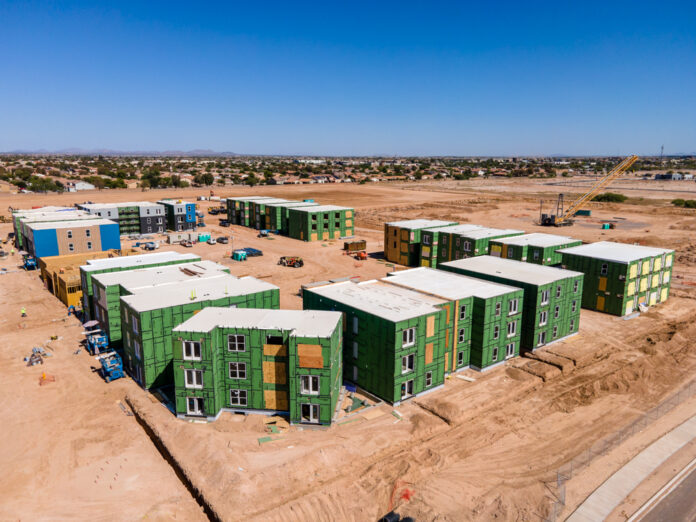
There is much talk around town about the increasing number of multi-family housing units being approved in Maricopa. But one of the first such projects, which contains several innovative elements, is flying under the radar.
West Maricopa Village is a 35-acre, mixed-use development sprouting at the southeast corner of Loma Road and State Route 238, just west of Acacia Crossing. The development lies to the north of the Estrella Gin Office Park in development and east of the proposed PHX Surf waterpark.
The project consists of two primary elements: 182 one- and two-bedroom, single-family homes for rent on 16.3 acres on the property’s east side, to be known as Innovation Village; and 342 apartment units known as FlatZ 520 being built by Z Modular. FlatZ 520 will feature one-, two- and three-story modular buildings on 14 acres between Innovation Village and Loma Road.
The modular design of FlatZ 520 sets it apart from other projects in the city, according to Luke Allen, asset manager with Z Modular’s parent company, Zekelman Industries. First, the modular process cuts construction time by up to 50%, especially in today’s climate of increasing materials costs and supply chain delays. The units are built in a manufacturing facility in Chandler, then shipped to Maricopa for assembly and stacking.
Allen said the process reduces costs, primarily around the speed with which the company can get its product to market.
“Not only are we bringing much-needed housing to the community faster – our communities begin to lease earlier than traditional ground-up,” Allen said.
But those savings are not necessarily being passed on to tenants in the form of lower rents.
“At this time, these apartments are following the same market rate cost of housing in the market,” Allen said. “We are hopeful that these rates will be reasonable for the quality of housing provided. We have not established rental rates at this time (but) should have established rental rates on our website 60-90 days from opening the community in the spring of 2023.”
The community will consist of 24 studio units (596 square feet); 120 one-bedroom, one-bath apartments (677 square feet); 168 two-bedroom, two-bath homes (1,047 square feet); and 36 three-bedroom, three-bath units (1,177 square feet).
Allen said prospective residents will be able to begin touring units 30-60 days prior to opening. The community, which will be managed by Greystar Property Management Group, will have signage and a website for prospective residents to learn more about the community in the coming weeks, including how prospective residents can get on a waiting list.
While the unique nature of their design may give some pause about their safety, the modular construction is equally, if not more safe, than traditional construction methods, Allen said.
The units are constructed with non-combustible materials, he said.
West Maricopa Village is part of a push by the city over the past two years to increase the number of multi-family housing options in Maricopa. Until the Oasis at the Wells Apartments opened last year, every housing unit in the city was a single-family home for sale. There were no rental units other than those single-family homes.
The City identified a need for multi-family housing that is affordable for entry-level professionals, such as teachers, nurses, police, firefighters and retail workers. That need has been determined to be 25% of the city’s total housing units.
The city currently has an inventory of 70,400 entitled single-family housing units, with 24,345 units completed. To reach its 25% goal, the City will need 17,600 of those total units to be multi-family units. Currently, there are 2,135 entitled multi-family units, with just 670 already completed.
Of the 24,345 built housing units in Maricopa, 6,253 of them should be multi-family units, according to the 25% goal. But with 1,738 multi-family units currently in some stage of land use entitlement proceedings, multi-family housing represents just 8.7% of the total current stock.
City officials including City Manager Rick Horst have repeatedly stressed the need for this type of workforce housing as a key to attracting businesses and industry, and retaining coveted young professional workers. Many of those workers, Horst has said, simply cannot afford to buy a single-family home whose median value in Maricopa in April rose to $410,000.
In addition, Horst said, multi-family housing will attract people who can both live and work in the city, keeping more spending in the city and supporting the infrastructure needed for the coming growth.
“I have shared in the past our need for ‘circle of life’ housing – multiple options to fit community needs,” Horst said. “These units will meet the needs of our community workforce to include police officers, schoolteachers, fire fighters and service workers.”
Horst added multi-family units provide a place for seniors who no longer can, or are willing to, maintain a large home when their children are grown.
According to Ron Smith, vice president at Matrix Equities, the developer of Innovation Village, demand is soaring for these types of housing in Maricopa.
“That’s the driving force – there is just a lot of demand for this product,” Smith said. “The number of units (a 2017 study) indicated would be needed, we’re approaching that number, but we haven’t passed it. I feel strongly that there is a demand for our apartment units and our villa product in Maricopa.”
In addition to residential, West Maricopa Village includes a mixed-use component that could include more residential, such as apartments, condominiums or townhouses on the upper floors and commercial usage on the ground floor. The area also is likely to have a gas station, convenience store and/or a car wash. A final phase would include planned retail, commercial or medical office space.





![Maricopa’s ‘TikTok Rizz Party,’ explained One of several flyers for a "TikTok rizz party" is taped to a door in the Maricopa Business Center along Honeycutt Road on April 23, 2024. [Monica D. Spencer]](https://www.inmaricopa.com/wp-content/uploads/2024/04/spencer-042324-tiktok-rizz-party-flyer-web-218x150.jpg)






![Alleged car thief released without charges Phoenix police stop a stolen vehicle on April 20, 2024. [Facebook]](https://www.inmaricopa.com/wp-content/uploads/2024/04/IMG_5040-218x150.jpg)




